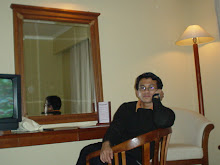In its early stages of development, television included only those devices employing a combination of optical, mechanical and electronic technologies to capture, transmit and display a visual image. By the late 1920s, however, those employing only optical and electronic technologies were being explored. All modern television systems rely on the latter, however the knowledge gained from the work on mechanical-dependent systems was crucial in the development of fully electronic television.
In 1884 Paul Gottlieb Nipkow, a 20-year old university student in Germany patented the first electromechanical television system which employed a scanning disk, a spinning disk with a series of holes spiraling toward the center, for "rasterization", the process of converting a visual image into a stream of electrical pulses. The holes were spaced at equal angular intervals such that in a single rotation the disk would allow light to pass through each hole and onto a light-sensitive selenium sensor which produced the electrical pulses. As an image was focused on the rotating disk, each hole captured a horizontal "slice" of the whole image.
Nipkow's design would not be practical until advances in amplifier tube technology became available in 1907. Even then the device was only useful for transmitting still halftone images - those represented by equally spaced dots of varying size - over telegraph or telephone lines. Later designs would use a rotating mirror-drum scanner to capture the image and a cathode ray tube (CRT) as a display device, but moving images were still not possible, due to the poor sensitivity of the selenium sensors.
Scottish inventor John Logie Baird demonstrated the transmission of moving silhouette images in London in 1925, and of moving, monochromatic images in 1926. Baird's scanning disk produced an image of 30 lines resolution, barely enough to discern a human face, from a double spiral of lenses.
By 1927, Russian inventor Léon Theremin developed a mirror drum-based television system which used interlacing to achieve an image resolution of 100 lines.
Also in 1927, Herbert E. Ives of Bell Labs transmitted moving images from a 50-aperture disk producing 16 frames per minute over a cable from Washington, DC to New York City, and via radio from Whippany, New Jersey. Ives used viewing screens as large as 24 by 30 inches (60 by 75 centimeter). His subjects included Secretary of Commerce Herbert Hoover.
(This summary drawn from History of television remains incomplete. See Talk:Television "Move "History of television" into this article."
Langganan:
Posting Komentar (Atom)








Tidak ada komentar:
Posting Komentar